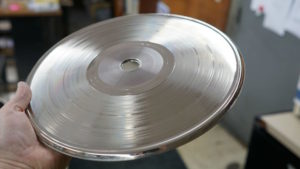- in Book Excerpt , Gear , Hardware by Bobby Owsinski
How A Vinyl Record Is Pressed
 There’s so much attention given to vinyl these days that I though it might be a good idea to cover exactly what goes into actually pressing a record. It’s actually a primitive process by today’s standards, and it’s pretty amazing that they sound as good as they do. Here’s an excerpt from the 4rth edition of my Mastering Engineer’s Handbook that shows just how much of a multi-step operation vinyl record pressing is.
There’s so much attention given to vinyl these days that I though it might be a good idea to cover exactly what goes into actually pressing a record. It’s actually a primitive process by today’s standards, and it’s pretty amazing that they sound as good as they do. Here’s an excerpt from the 4rth edition of my Mastering Engineer’s Handbook that shows just how much of a multi-step operation vinyl record pressing is.
Vinyl record pressing is virtually entirely mechanical and manual with a host of areas that could influence the end product in a mostly negative way. Here’s how it works:
Step 1: The master lacquer (the initial transfer to vinyl from a digital file) is used as the first of several metal molds from which the plastic records are pressed. The lacquer is first coated with a layer of tin and silver nitrate then dropped in a nickel sulfamate bath and electroplated. The lacquer is removed from the bath and the nickel coating is peeled away. The separated nickel is what’s known as the “metal master” and is a negative of the lacquer.
Step 2: The metal master is dropped back into the nickel bath and electroplated again. The resultant separated metal part is known as the “mother” and is a positive copy that can be played since it has grooves (although that would destroy the disc).
Step 3: The mother is dropped back into the nickel bath and electroplated again. The resultant separated metal part is known as the “stamper” and is a negative copy that is bolted into the record presser to actually stamp out the plastic records.
It should be noted that, just like tape, each resultant copy is a generation down and will result in 6dB worse signal to noise ratio. Also, great care must be used when peeling off the electroplating, since any material left behind will result in a pop or click on the finished product.
Step 4: The vinyl used to make records actually comes in a granulated form called “vinylite” and isn’t black, but honey colored. Before being pressed, it’s heated into the form of modeling clay and colored with pigment. At this point it’s known as a “biscuit.”
The biscuit is then placed in the press, which resembles a large waffle iron, and is heated to about 300 degrees. Temperature is important because if the press if too hot then the record will warp; too cold then the noise will increase. After pressing, excess vinyl is trimmed with a hot knife and the records are put on a spindle to cool at room temperature.
All of these metal parts wear out, and a stamper will go dull after about 70,000 pressings. Because of that, several sets of metal parts have to be made for a large order, and in the case of the big selling records of yesterday, even several master lacquers.
NOTE: For short runs of 50,000 and less, steps 2 and 3 are skipped.
New computerized vinyl record presses that are more efficient are finally being manufactured, but the time consuming electroplating process still remains.
You can read more from The Mastering Engineer’s Handbook and my other books on the excerpt section of bobbyowsinski.com.
[Image: Gruesomflowers]